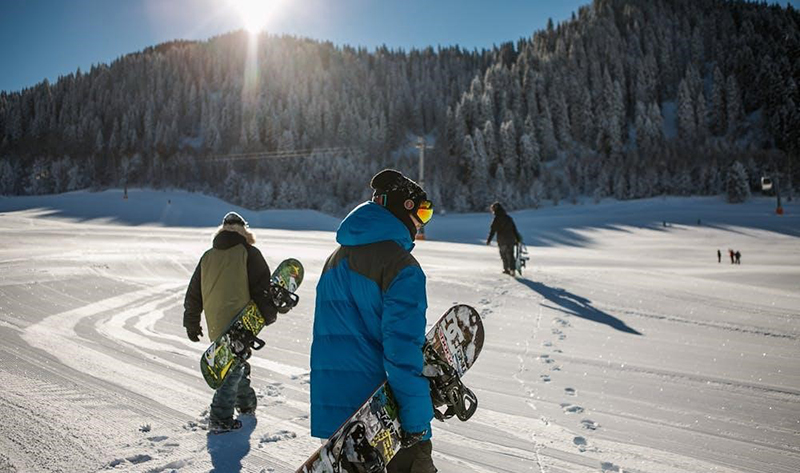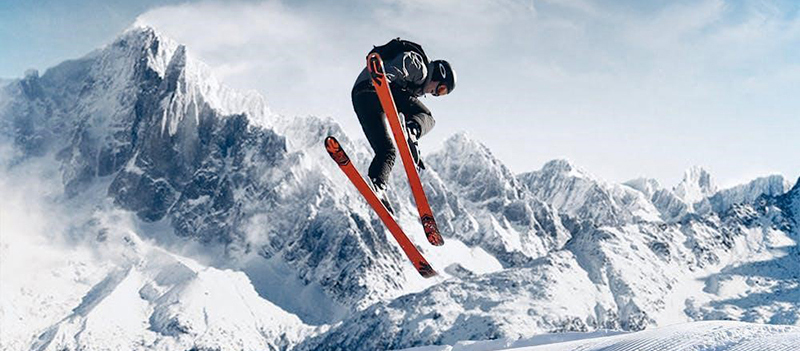The crisp mountain air, the glistening snow, and the thrill of gliding down a slope – winter sports offer an exhilarating escape for adventure seekers. From the classic elegance of skiing to the adrenaline rush of snowboarding, there’s a winter activity for everyone.
This guide will equip you with the knowledge and resources to prepare for an unforgettable winter sports holiday. Whether you’re a seasoned pro or a first-time enthusiast, we’ll cover everything from choosing the right gear to staying safe on the slopes.
But before you pack your bags and hit the powder, remember that proper preparation is key to a safe and enjoyable experience. From physical conditioning to understanding winter safety signs and travel insurance, this guide will help you maximise your winter sports adventure.
What Winter Sport Are There For You To Try?
When it comes to winter sports, skiing and snowboarding often take centre stage. Skiing, with its graceful turns and varied terrain, offers a timeless appeal. Snowboarding, on the other hand, provides a more contemporary and freestyle experience. Both activities offer a fantastic way to experience the mountains and enjoy the thrill of gliding through the snow.
Beyond these popular choices, a world of winter sports awaits. Ice skating, with its elegance and artistry, provides a different kind of thrill on the ice. Snowshoeing offers a peaceful way to explore snowy landscapes, while ice climbing presents a challenging and rewarding experience for adventurous souls.
To help you choose the perfect winter sports destination, here are some recommendations based on your preferred activity:
- Switzerland: Renowned for its world-class ski resorts, Switzerland offers a quintessential skiing experience. Zermatt, with its iconic Matterhorn backdrop, and St. Moritz, known for its luxury and challenging slopes, are top choices for ski enthusiasts.
- Japan: If powder snowboarding is your passion, Japan is the place to be. Hokkaido, with its abundant snowfall and legendary powder, attracts snowboarders from around the globe. Hakuba Valley, with its diverse terrain and Olympic heritage, is another popular choice.
- Canada: Whistler Blackcomb, in British Columbia, is a haven for winter sports lovers. With its vast terrain, varied slopes, and lively après-ski scene, it caters to skiers and snowboarders of all levels.
- Austria: Innsbruck, nestled in the Austrian Alps, offers a charming blend of winter sports and cultural experiences. With its Olympic history and access to world-class ski resorts, it’s a great option for those seeking a diverse winter holiday.
- Norway: For a unique winter sports experience, consider Norway. With its stunning fjords, northern lights, and opportunities for cross-country skiing and dog-sledding, it offers a different perspective on winter adventures.
Gearing Up for Winter Sports: Essential Equipment and Clothing
Having the right gear will keep you safe while you’re up on the slopes. Essential equipment typically includes skis or a snowboard, boots, and a helmet. Optional items might include poles, goggles, and wrist guards, depending on your chosen activity and personal preferences.
When it comes to equipment, you have the choice of renting or buying. Renting is a convenient and cost-effective option, especially if you’re a beginner or only ski occasionally. It allows you to try different types of gear before investing in your own. However, if you’re a frequent skier or snowboarder, buying your own equipment can be a worthwhile investment in the long run. It allows you to customise your gear to your preferences and ensures it fits perfectly.
Here’s a breakdown of how to choose the right size and fit for your winter sports gear:
- Skiing
- Skis: Your skis should reach somewhere between your chin and the top of your head. Consider your skill level and preferred terrain when choosing ski length and type. Longer skis offer more stability at higher speeds, while shorter skis are more manoeuvrable.
- Ski Boots: Ski boots should fit snugly but not be too tight. Your toes should barely touch the end of the boot when you’re standing upright, but you should be able to wiggle them when you flex your ankles.
- Ski Poles: Hold the pole upside down with your hand under the basket. Your elbow should be bent at a 90-degree angle when the pole tip touches the ground
- Snowboarding
- Snowboard: When standing on its end, the snowboard should reach somewhere between your chin and your nose. Consider your weight, riding style, and preferred terrain when choosing board length and type.
- Snowboard Boots: Similar to ski boots, snowboard boots should fit snugly but allow for comfortable movement. Your toes should lightly touch the end of the boot when you’re standing upright.
- General Gear Tips
- Helmet: A properly fitted helmet should sit level on your head, covering your forehead, and shouldn’t move around when you shake your head.
- Goggles: Goggles should fit snugly against your face, creating a seal to prevent wind and snow from getting in. Ensure they offer good visibility and UV protection.
- Gloves: Choose waterproof gloves, insulated, and allow for a good grip. Consider mittens for extra warmth.
Winter Gear to Stay Warm During Your Winter Activities
Dressing for the cold is crucial for a comfortable and enjoyable winter sports experience. Layering is key, as it allows you to regulate your body temperature and stay warm without overheating. Start with a moisture-wicking base layer to keep sweat away from your skin.
Add an insulating mid-layer for warmth, and finish with a waterproof and breathable outer layer to protect you from the elements.
Here are some tips for choosing the right winter clothing:
- Base layers: Opt for thermal underwear made from materials like merino wool or synthetic fabrics that wick away moisture.
- Mid-layers: Fleece jackets, down vests, or wool sweaters provide excellent insulation.
- Outer layers: Choose a waterproof and breathable ski jacket and pants to protect you from snow, wind, and cold temperatures.
- Gloves: Waterproof and insulated gloves or mittens are essential for keeping your hands warm and dry.
- Hats: A warm hat that covers your ears is crucial for preventing heat loss.
- Socks: Choose moisture-wicking ski or snowboard socks to keep your feet warm and comfortable.
Staying Safe for Winter Sports

Safety should always be a top priority when participating in winter sports. While these activities are exhilarating, they also carry inherent risks. Being aware of potential hazards and taking necessary precautions can significantly reduce your chances of injury.
Common winter sports injuries include:
- Sprains and strains: These often occur due to sudden twists or falls. Warm up properly before hitting the slopes and wear supportive footwear to minimise the risk.
- Fractures: Collisions or falls at high speeds can lead to fractures. Always wear a helmet and be mindful of your surroundings to avoid collisions.
- Head injuries: Head injuries can be severe, even fatal. Wearing a helmet is crucial for protecting your head in case of a fall or collision.
- Hypothermia and frostbite: Prolonged exposure to cold temperatures can lead to hypothermia and frostbite. Dress in layers, take breaks to warm up, and stay hydrated to prevent these conditions.
Remember to familiarise yourself with winter safety signs and always stay within designated areas. Taking lessons from qualified instructors is highly recommended, especially for beginners. They can teach you proper techniques and safety protocols to enhance your skills and minimise risks.
Also, be aware of changing weather conditions and potential avalanche risks. Check the weather forecast before heading out, and heed any warnings or advisories issued by local authorities.
Tips and Tricks for Each Winter Sport
Skiing
Mastering the basics of skiing involves learning how to stop, turn, and control your speed effectively. Start on beginner slopes with gentle gradients and gradually progress to more challenging terrain as your confidence and skills grow. Remember to bend your knees, keep your weight centred, and use your edges to control your turns.
When navigating ski lifts, be patient and aware of your surroundings. Wait your turn in the queue and follow the instructions of the lift operators. Once on the lift, keep your skis pointed forward and avoid swinging your legs or making sudden movements. On the slopes, be mindful of other skiers and snowboarders to avoid collisions.
Sledding
Sledding offers a fun and accessible way to enjoy the snow, but choosing the right sled for the terrain is important. Traditional toboggans are suitable for gentle slopes, while more specialised sleds, like snow tubes or saucers, are designed for steeper hills or snow parks.
When sledding, always choose a safe slope that is free of obstacles like trees, rocks, or fences. Avoid sledding on icy surfaces or near roads. To steer your sled, lean in the direction you want to turn and use your feet to help guide your direction.
Snowboarding
Snowboarding requires balance, coordination, and a sense of adventure. Start by practising on a gentle slope to get a feel for the board and learn how to control your edges. Bend your knees, keep your weight centred, and use your heels and toes to steer.
As you progress, experiment with different types of terrain, such as groomed runs, powder, and terrain parks. Always be aware of your surroundings and maintain a safe distance from other snowboarders and skiers.
Ice Skating
Ice skating encompasses various disciplines, from the graceful spins and jumps of figure skating to the speed and agility of speed skating. Whether you’re gliding leisurely or practising intricate moves, ice skating offers a delightful way to enjoy the ice.
For beginners, staying balanced is key. Start by holding onto the sideboards for support. Practice marching in place to get a feel for the ice, then gradually try gliding with small steps. Bend your knees slightly and keep your weight balanced to maintain stability.
Planning Your Winter Sports Getaway
Choosing the right destination for your winter sports holiday depends on various factors, including your budget, preferred activities, and desired experience. Consider factors like travel time, visa requirements, and local regulations when making your decision. Research different resorts and their offerings to find the perfect fit for your needs and skill level.
When booking flights and accommodation, consider booking in advance, especially if you’re travelling during peak season. Look for package deals that combine flights, accommodation, and lift tickets for potential savings. Consider staying in a ski-in/ski-out location for convenient access to the slopes.
Remember to pack essential items like warm clothing, waterproof outerwear, sunscreen, and sunglasses. Don’t forget your travel documents, including your passport, visa (if required), and ski holiday insurance or winter sports holiday insurance policy that covers everything from lost baggage to travel delays.
Are You Ready to Shred Snow on Your Winter Adventure?
Preparing for a winter sports adventure involves more than just packing your bags and hitting the slopes. By prioritising safety, choosing the right gear, and understanding the nuances of your chosen activity, you can ensure a truly rewarding and memorable experience.
Embrace the thrill of winter sports, but remember that safety and preparation go hand-in-hand with enjoyment. By taking the necessary precautions and equipping yourself with the right knowledge and gear, you can create lasting memories on your winter sports holiday.
Before you embark on your winter adventure, ensure you have adequate protection with travel insurance that covers winter sports and accidents that occur overseas. HL Assurance’s COVIDSafe Travel Protect360 travel insurance covers most winter activities, with the exception of ski racing, backcountry skiing or off-piste skiing, ski jumping, and sledding with the use of a bobsleigh or skeleton. Our holiday insurance also covers medical evacuation so you can be safely escorted off the mountains if need be.
Explore our travel insurance options today and enjoy your winter sports holiday to the fullest!







